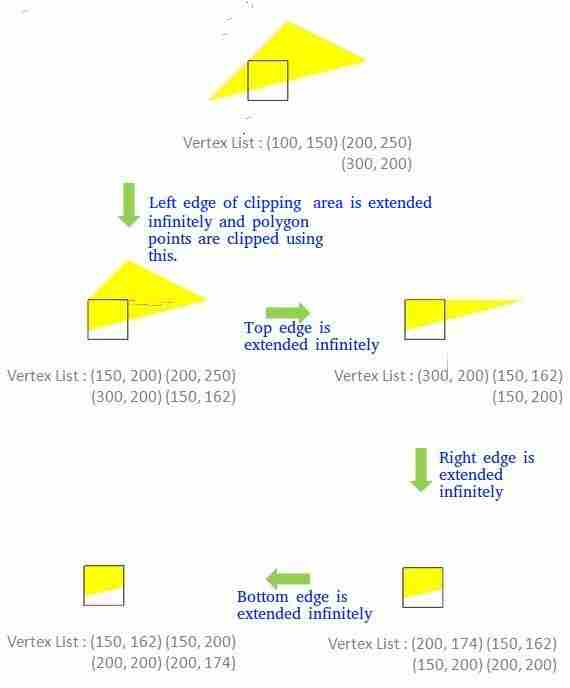给出了一个凸多边形和一个凸裁剪区域。任务是使用Sutherland–Hodgman算法剪裁多边形边。输入是以多边形顶点的形式输入的 顺时针顺序 .
null
例如:
Input : Polygon : (100,150), (200,250), (300,200)
Clipping Area : (150,150), (150,200), (200,200),
(200,150) i.e. a Square
Output : (150, 162) (150, 200) (200, 200) (200, 174)
 Example 2
Input : Polygon : (100,150), (200,250), (300,200)
Clipping Area : (100,300), (300,300), (200,100)
Output : (242, 185) (166, 166) (150, 200) (200, 250) (260, 220)
Example 2
Input : Polygon : (100,150), (200,250), (300,200)
Clipping Area : (100,300), (300,300), (200,100)
Output : (242, 185) (166, 166) (150, 200) (200, 250) (260, 220)

算法概述:
Consider each edge e of clipping Area and do following: a) Clip given polygon against e.
如何根据剪裁区域的边缘进行剪裁? 将(剪裁区域的)边无限延伸以创建边界,并使用该边界剪裁所有顶点。生成的新顶点列表将以顺时针方式传递到剪辑多边形的下一条边,直到所有边都已使用。
给定多边形的任意给定边与当前剪切边e之间存在四种可能的情况。
- 两个顶点都在内部: 只有第二个顶点被添加到输出列表中
- 第一个顶点在外部,第二个顶点在内部: 边与剪辑边界的交点和第二个顶点都将添加到输出列表中
- 第一个顶点在内侧,第二个顶点在外侧: 只有边与剪辑边界的交点才会添加到输出列表中
- 两个顶点都在外部: 没有顶点添加到输出列表中
在实现算法之前,需要讨论两个子问题:-
决定一个点是在裁剪器多边形的内部还是外部 如果裁剪器多边形的顶点是按顺时针顺序给定的,则所有位于该多边形上的点 右侧 其中一条修剪器边位于该多边形内。这可以使用以下公式计算: 
查找边与剪辑边界的交点的步骤 如果每条直线(1,2和3,4)的两个点已知,则可以使用以下公式计算它们的交点:- 
// C++ program for implementing Sutherland–Hodgman // algorithm for polygon clipping #include<iostream> using namespace std; const int MAX_POINTS = 20; // Returns x-value of point of intersection of two // lines int x_intersect( int x1, int y1, int x2, int y2, int x3, int y3, int x4, int y4) { int num = (x1*y2 - y1*x2) * (x3-x4) - (x1-x2) * (x3*y4 - y3*x4); int den = (x1-x2) * (y3-y4) - (y1-y2) * (x3-x4); return num/den; } // Returns y-value of point of intersection of // two lines int y_intersect( int x1, int y1, int x2, int y2, int x3, int y3, int x4, int y4) { int num = (x1*y2 - y1*x2) * (y3-y4) - (y1-y2) * (x3*y4 - y3*x4); int den = (x1-x2) * (y3-y4) - (y1-y2) * (x3-x4); return num/den; } // This functions clips all the edges w.r.t one clip // edge of clipping area void clip( int poly_points[][2], int &poly_size, int x1, int y1, int x2, int y2) { int new_points[MAX_POINTS][2], new_poly_size = 0; // (ix,iy),(kx,ky) are the co-ordinate values of // the points for ( int i = 0; i < poly_size; i++) { // i and k form a line in polygon int k = (i+1) % poly_size; int ix = poly_points[i][0], iy = poly_points[i][1]; int kx = poly_points[k][0], ky = poly_points[k][1]; // Calculating position of first point // w.r.t. clipper line int i_pos = (x2-x1) * (iy-y1) - (y2-y1) * (ix-x1); // Calculating position of second point // w.r.t. clipper line int k_pos = (x2-x1) * (ky-y1) - (y2-y1) * (kx-x1); // Case 1 : When both points are inside if (i_pos < 0 && k_pos < 0) { //Only second point is added new_points[new_poly_size][0] = kx; new_points[new_poly_size][1] = ky; new_poly_size++; } // Case 2: When only first point is outside else if (i_pos >= 0 && k_pos < 0) { // Point of intersection with edge // and the second point is added new_points[new_poly_size][0] = x_intersect(x1, y1, x2, y2, ix, iy, kx, ky); new_points[new_poly_size][1] = y_intersect(x1, y1, x2, y2, ix, iy, kx, ky); new_poly_size++; new_points[new_poly_size][0] = kx; new_points[new_poly_size][1] = ky; new_poly_size++; } // Case 3: When only second point is outside else if (i_pos < 0 && k_pos >= 0) { //Only point of intersection with edge is added new_points[new_poly_size][0] = x_intersect(x1, y1, x2, y2, ix, iy, kx, ky); new_points[new_poly_size][1] = y_intersect(x1, y1, x2, y2, ix, iy, kx, ky); new_poly_size++; } // Case 4: When both points are outside else { //No points are added } } // Copying new points into original array // and changing the no. of vertices poly_size = new_poly_size; for ( int i = 0; i < poly_size; i++) { poly_points[i][0] = new_points[i][0]; poly_points[i][1] = new_points[i][1]; } } // Implements Sutherland–Hodgman algorithm void suthHodgClip( int poly_points[][2], int poly_size, int clipper_points[][2], int clipper_size) { //i and k are two consecutive indexes for ( int i=0; i<clipper_size; i++) { int k = (i+1) % clipper_size; // We pass the current array of vertices, it's size // and the end points of the selected clipper line clip(poly_points, poly_size, clipper_points[i][0], clipper_points[i][1], clipper_points[k][0], clipper_points[k][1]); } // Printing vertices of clipped polygon for ( int i=0; i < poly_size; i++) cout << '(' << poly_points[i][0] << ", " << poly_points[i][1] << ") " ; } //Driver code int main() { // Defining polygon vertices in clockwise order int poly_size = 3; int poly_points[20][2] = {{100,150}, {200,250}, {300,200}}; // Defining clipper polygon vertices in clockwise order // 1st Example with square clipper int clipper_size = 4; int clipper_points[][2] = {{150,150}, {150,200}, {200,200}, {200,150} }; // 2nd Example with triangle clipper /*int clipper_size = 3; int clipper_points[][2] = {{100,300}, {300,300}, {200,100}};*/ //Calling the clipping function suthHodgClip(poly_points, poly_size, clipper_points, clipper_size); return 0; } |
输出:
(150, 162) (150, 200) (200, 200) (200, 174)
相关文章: 线裁剪|集1(科恩-萨瑟兰算法) 计算机图形学中的点裁剪算法
本文由 纳巴内特·罗伊 .如果你喜欢GeekSforgek,并想贡献自己的力量,你也可以使用 写极客。组织 或者把你的文章寄去评论-team@geeksforgeeks.org.看到你的文章出现在Geeksforgeks主页上,并帮助其他极客。
如果您发现任何不正确的地方,或者您想分享有关上述主题的更多信息,请写下评论。
© 版权声明
文章版权归作者所有,未经允许请勿转载。
THE END



![关于”PostgreSQL错误:关系[表]不存在“问题的原因和解决方案-yiteyi-C++库](https://www.yiteyi.com/wp-content/themes/zibll/img/thumbnail.svg)



